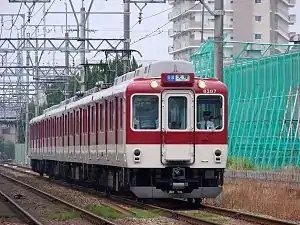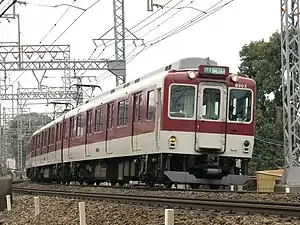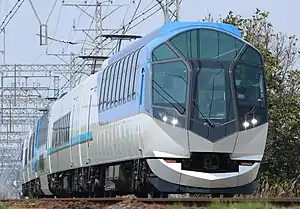Kintetsu 8000 series
The Kintetsu 8000 series (近鉄8000系, Kintetsu 8000-kei) is an electric multiple unit (EMU) train type operated by the private railway operator Kintetsu Railway since 1964 on many of its commuter lines in the Kansai area of Japan.

Design
First introduced in 1964, the design is based on the Kintetsu 900 series commuter train, also manufactured by Kinki Sharyo. All trainsets run on standard gauge 1,435 mm (4 ft 8+1⁄2 in) tracks.
At the time of introduction, the 8000 series and its sub-variants were the most common type found on the railway at 355 cars produced.
Variants
- 8000 series: 2-car and 4-car sets primarily used on the Nara Line[1]
- 8400 series: 2-car, 3-car and 4-car sets primarily used on the Nara Line with various improvements from the base model
- 8600 series: 4-car sets primarily used on the Nara Line with upgraded cooling systems
- 8800 series: 4-car sets primarily used on the Nara Line designated as test units for regenerative braking
8000 series
| 8000 series | |
|---|---|
 Set 8086 passing Hiraoka Station | |
| In service | 1964–present |
| Manufacturer | Kinki Sharyo |
| Constructed | 1964–1980 |
| Entered service | 1964 |
| Refurbished | 2003–2004 |
| Scrapped | 1996–2019 |
| Number built | 208 vehicles (68 sets) |
| Number in service | 34 vehicles (9 sets) |
| Number scrapped | 174 vehicles |
| Formation | 2-, 3-, or 4-cars per trainset |
| Fleet numbers | Various |
| Capacity | 170 (end cars) 190 (intermediate cars) |
| Operator(s) | Kintetsu Railway |
| Depot(s) |
|
| Line(s) served | |
| Specifications | |
| Car length | 20,720 mm (67 ft 11+3⁄4 in)[2] |
| Width | 2,800 mm (9 ft 2+1⁄4 in) |
| Height | 4,012 mm (13 ft 2 in) Cars with electric fans |
| Doors | 4 pairs per side |
| Maximum speed | 105 km/h (65 mph) |
| Power output | 145 kW (194 hp) per motor |
| Electric system(s) | 1,500 V DC Overhead wire |
| Current collector(s) | Pantograph |
| Bogies |
|
| Track gauge | 1,435 mm (4 ft 8+1⁄2 in) |
The 8000 series is the base variant in the 8000 series family.[2]
Set 8059 was involved in the 1972 Nara Line bombing incident. Afterwards, the cars were reincorporated into different trainsets by 1976.
Formations
The 4-car sets are formed as follows.[3]
| Car No. | 1 | 2 | 3 | 4 |
|---|---|---|---|---|
| Numbering | Ku 8700 | Mo 8000 | Mo 8200 | Ku 8500 |
The 3-car sets are formed as follows.
| Car No. | 1 | 2 | 3 |
|---|---|---|---|
| Numbering | Mo 8000 | Mo 8250 | Ku 8500 |
Past formations
Until 2004 and for a brief while in 2014, the series was formed into some two-car trainsets.
| Car No. | 1 | 2 |
|---|---|---|
| Numbering | Mo 8000 | Ku 8500 |
In 1968, one four-car set, (#8069) and one two-car set (#8074) were combined into a 6-car train as an aluminum prototype.[2] The set was scrapped in 2005.
| Car No. | 1 | 2 | 3 | 4 | 5 | 6 |
|---|---|---|---|---|---|---|
| Numbering | Mo 8000 | Sa 8710 | Mo 8210 | Sa 8500 | Mo 8000 | Ku 8500 |
Interior
Seating consists of longitudinal seating throughout.
 8000 series interior with updated seat fabric
8000 series interior with updated seat fabric
Disposal
Scrapping began in 1997 with eight sets, with more sets gradually undergoing disposal until 2004.
As of 1 April 2019, two 3-car sets and 7 4-car sets remain in service.[2] No two-car sets remain.
8400 series
| 8400 series | |
|---|---|
 Set 8407 on a service to Tenri | |
| In service | 1969–present |
| Manufacturer | Kinki Sharyo |
| Constructed | 1969–1972 |
| Entered service | 1969 |
| Refurbished | 2003 |
| Scrapped | 2004–2019 |
| Number built | 80 vehicles (16 sets) |
| Number in service | 45 vehicles (11 sets) |
| Number scrapped | 35 vehicles |
| Formation | 2- or 4-cars per trainset |
| Fleet numbers | Various |
| Capacity | 170 (end cars) 190 (intermediate cars) |
| Operator(s) | Kintetsu Railway |
| Depot(s) |
|
| Line(s) served | |
| Specifications | |
| Car length | 20,720 mm (67 ft 11+3⁄4 in) |
| Width | 2,800 mm (9 ft 2+1⁄4 in) |
| Height | 4.15 m (13 ft 7+3⁄8 in)Cars with electric fans |
| Doors | 4 pairs per side |
| Maximum speed | 105 km/h (65.2 mph) |
| Power output | 145 kW (194 hp) per motor |
| Electric system(s) | 1,500 V DC Overhead wire |
| Current collector(s) | Pantograph |
| Bogies |
|
| Track gauge | 1,435 mm (4 ft 8+1⁄2 in) |
The 8400 series are 8000 series sets with modifications to the location of various onboard equipment. The three-car sets are re-fitted for wanman driver-only operation.[3]
Formations
The 4-car sets are formed as follows.
| Car No. | 1 | 2 | 3 | 4 |
|---|---|---|---|---|
| Numbering | Ku 8350 | Mo 8400 | Mo 8450 | Ku 8300 |
The 3-car sets are formed as follows.
| Car No. | 1 | 2 | 3 |
|---|---|---|---|
| Numbering | Mo 8400 | Mo 8450 | Ku 8300 |
Past formations
Until 2014, there was a lone two-car trainset.
| Car No. | 1 | 2 |
|---|---|---|
| Numbering | Mo 8400 | Ku 8300 |
Interior
Seating consists of longitudinal seating throughout.
Disposal
Scrapping began in 2004 with set 8401, with more sets gradually undergoing disposal through 2019.
As of April 1, 2019, 45 of 80 cars, consisting of seven 3-car sets and six 4-car sets, remain in service.[2] The sole 2-car set was withdrawn and scrapped in 2014.
Gallery
8600 series
| 8600 series | |
|---|---|
 Set 8606 near Kawachi-Hanazono Station | |
| In service | 1973–present |
| Manufacturer | Kinki Sharyo |
| Constructed | 1973–1979 |
| Entered service | 1973 |
| Refurbished | 2003–2004 |
| Scrapped | 1996–2019 |
| Number built | 84 vehicles (21 sets) |
| Number in service | 86 vehicles (21 sets) |
| Number scrapped | 174 vehicles |
| Formation | 4- or 6-cars per trainset |
| Fleet numbers | Various |
| Capacity | 170 (end cars) 190 (intermediate cars) |
| Operator(s) | Kintetsu Railway |
| Depot(s) |
|
| Line(s) served | |
| Specifications | |
| Car length | 20,720 mm (67 ft 11+3⁄4 in) |
| Width | 2,800 mm (9 ft 2+1⁄4 in) |
| Height | 4.012 m (13 ft 2 in)Cars with electric fans |
| Doors | 4 pairs per side |
| Maximum speed | 105 km/h (65 mph) |
| Power output | 145 kW (194 hp) per motor |
| Electric system(s) | 1,500 V DC Overhead wire |
| Current collector(s) | Pantograph |
| Bogies |
|
| Track gauge | 1,435 mm (4 ft 8+1⁄2 in) |
| Notes/references | |
| One set contains the two rebuilt 8000 series cars from the 1972 Nara Line bombing | |
The 8600 series started appearing in 1973.
Formations
The four-car sets are formed as follows.
| Car No. | 1 | 2 | 3 | 4 |
|---|---|---|---|---|
| Designation | Mo 8600 | Sa 8150 | Mo 8650 | Ku 8100 |
The four-car sets involved in field phase control are formed as follows.
| Car No. | 1 | 2 | 3 | 4 |
|---|---|---|---|---|
| Designation | Ku 8150 | Mo 8600 | Mo 8650 | Ku 8100 |
The lone six-car set is formed as follows.
| Car No. | 1 | 2 | 3 | 4 | 5 | 6 |
|---|---|---|---|---|---|---|
| Designation | Mo 8600 | Sa 8150 | Mo 8650 | Sa 8150 | Mo 8650 | Ku 8100 |
Interior
Seating consists of longitudinal seating throughout.
Gallery
 Interior of 8622
Interior of 8622
8800 series
| 8800 series | |
|---|---|
 Set 8804 on the Nara Line | |
| In service | 1980–present |
| Manufacturer | Kinki Sharyo |
| Constructed | 1980 |
| Entered service | 1980 |
| Refurbished | 1999 |
| Number built | 8 vehicles (2 sets) |
| Number in service | 8 vehicles (2 sets) |
| Formation | 4-cars per trainset |
| Fleet numbers | 8901, 8903 |
| Capacity | 170 (end cars) 190 (intermediate cars) |
| Operator(s) | Kintetsu Railway |
| Depot(s) |
|
| Line(s) served | |
| Specifications | |
| Car length | 20,720 mm (67 ft 11+3⁄4 in) |
| Width | 2,800 mm (9 ft 2+1⁄4 in) |
| Doors | 4 pairs per side |
| Maximum speed | 105 km/h (65 mph) |
| Power output | 145 kW (194 hp) per motor |
| Electric system(s) | 1,500 V DC Overhead wire |
| Current collector(s) | Pantograph |
| Bogies |
|
| Track gauge | 1,435 mm (4 ft 8+1⁄2 in) |
This sub-series features regenerative braking.
Formations
| Car No. | 1 | 2 | 3 | 4 |
|---|---|---|---|---|
| Designation | Ku 8900 | Mo 8800 | Mo 8800 | Ku 8900 |
Interior
Seating consists of longitudinal seating throughout.
Gallery
 Interior of 8802
Interior of 8802 Priority seating section of 8802 after seat remodelling work
Priority seating section of 8802 after seat remodelling work
References
- 飯島・藤井・井上 (2002). 復刻版 私鉄の車両13 近畿日本鉄道II [Kinki Nihon Railway 2, Commuter Vehicle and More] (in Japanese). Japan: Neko Publishing. pp. 170–173. ISBN 978-4873662961.
- 三好, 好三 (2016). 近鉄電車 [Kintetsu Railway] (in Japanese). Japan: JTBパブリッシング. p. 83. ASIN B06X9G6SQK. ISBN 9784533114359.
- 飯島, 巌 (2002). 復刻版 私鉄の車両13 近畿日本鉄道II [Kinki Nihon Railway 2, Commuter Vehicle and More] (in Japanese). Japan: ネコ・パブリッシング. p. 12. ISBN 978-4873662961.
